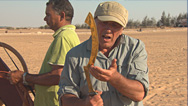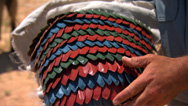The Egyptian Bow
- Posted 05.23.13
- NOVA
Water buffalo tusks, fish bladders, and animal sinew all went into the making of the ancient Egyptian composite bow. While the materials may seem primitive, this powerful weapon was not so different from the bows of today.
Transcript
The Egyptian Bow
Posted: May 23, 2013
Mike Loades: At the same time that the horse and chariot came to Egypt, so did a revolutionary new bow: the composite bow. Very, very powerful bow.
The bows they had before were just made of wood. This would be very clumsy in a chariot. And wood needs to be a certain length. You can’t have a short bow made of wood, cause that will only come back so far before that happens. So you have to have a certain amount of length for a wooden bow to work. Also, don’t be confused by its great girth. That doesn’t necessarily signify power. I could pull that back with one finger quite easily.
What we’ve got with the composite bow is something that’s short, therefore quite usable on the tight platform of a chariot, but immensely powerful. And it’s immensely powerful for two reasons: one is its composite materials, and two is its shape.
You see this unstrung, you’ll see it’s a completely different shape. It comes into this sort of flattened “W” shape. And that means all these materials are pre-stressed so that when it’s pulled back, these are already trying to go that way. So it’s a much more efficient spring.
And the way that happens is, you start with wood just as a former. The wood is jointed to give you the angles you want in that. And then you laminate on strips of horn from the water buffalo. Water buffalo horn—this is the power of it. This is the muscles. It’s a wonderful material for resisting compression. So if we think of this as the skeleton, this is then the muscles on here. We’re storing all that energy. We can then pre-stress the shape.
But there’s so much power in this horn that it would break apart unless it was held together, like our body is held together by tendons. You actually use sinew. This is sinew from an ox. If you hammer them—bash them with a stone—they become quite fibrous and start to pull apart. And if you keep working it, you will get it as fine as hair and extremely tough as well. I mean, this is incredibly—just even one strand is an incredibly strong material. I cannot break it. And that is then glued around the horn and the wood. You do layers and layers. All the art of making a bow is in the laying of the sinews. And it’s all held together with this, which is the dried swim bladders of fish. So you just break this stuff up and boil it in water, and you get this wonderful viscous glue.
Today, making modern composite bows, we use carbon fiber, doing the same job as the buffalo horn. We use fiber glass exactly the same as this sinew. And it’s bonded together with a resin just like this fish glue.
So, it really was a revolutionary technology at its time. And it absolutely changed the face of warfare. It enabled the Egyptians to go out onto the battlefield with their chariots and with their hit and run tactics. And that was new, and that created an empire.
Credits
PRODUCTION CREDITS
- Original Footage
- ©WGBH Educational Foundation 2013
IMAGE CREDITS
- (main image: shooting an arrow)
- ©WGBH Educational Foundation 2013
Related Links
-

Building Pharaoh's Chariot
A team uncovers the advanced engineering behind an ancient Egyptian war machine.
-

Chariot Weapons
A military historian demonstrates how the ancient Egyptians fought from their chariots.
-

Egyptian Armor
How did the ancient Egyptians protect themselves during battle?
-

Building Pharaoh's Ship
Can the legendary trading vessel of an Egyptian queen sail again?

